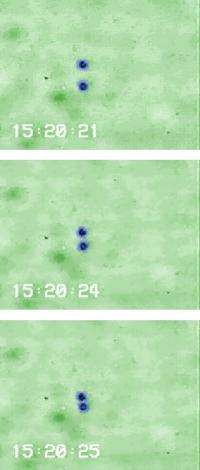'Micro-boxes' of water used to study single molecules
Researchers at the National Institute of Standards and Technology have demonstrated the use of water droplets as minuscule "boxes" for small numbers of biomolecules. The unusually simple containment method may enable easier experiments on single molecule dynamics and perhaps lead to the development of molecule-sorting devices that might be used for medical screening or biotechnology research.
The work was reported in the July 3 issue of Applied Physics Letters.
The NIST team creates the boxes by briefly shaking a mixture of water, the biomolecules to be studied, and a fluorocarbon medium. Water droplets form in the oily fluorocarbon and naturally encapsulate one to several biomolecules. The researchers then watch through a microscope while using infrared lasers as "optical tweezers" to manipulate and combine the droplets (dubbed "hydrosomes") inside a tiny chamber on a slide.

A green laser is then used to excite the molecules in individual droplets, and the light emissions over several seconds are analyzed to count the molecules and observe other phenomena. The researchers use two sets of optical tweezers to move droplets together to fuse them and mix their contents. The team demonstrated the technique by trapping and manipulating droplets encapsulating various molecules (including a delicate protein that survived the shaking process), detecting the fluorescence signal from dye and protein molecules, and observing the transfer of energy from one end of a specially treated DNA molecule to the other.
Water offers several advantages over other methods for containing single molecules, such as attaching them to surfaces or placing them inside liposomes (artificial cells). The water droplets can be held far from any surface that might interfere, can readily encapsulate biomolecules (which prefer being in water as opposed to the fluorocarbon medium), and can readily fuse together to mix molecules or rapidly change their chemical environment.
The water droplets currently average about 300 nanometers in diameter and contain volumes measured in quadrillionths of liters; research is continuing to improve methods for controlling droplet size for different applications.
Citation: J.E. Reiner, A.M. Crawford, R.B. Kishore, L.S. Goldner, K. Helmerson and M.K. Gilson. 2006. Optically trapped aqueous droplets for single molecule studies. Applied Physics Letters. July 3.
Source: National Institute of Standards and Technology




















